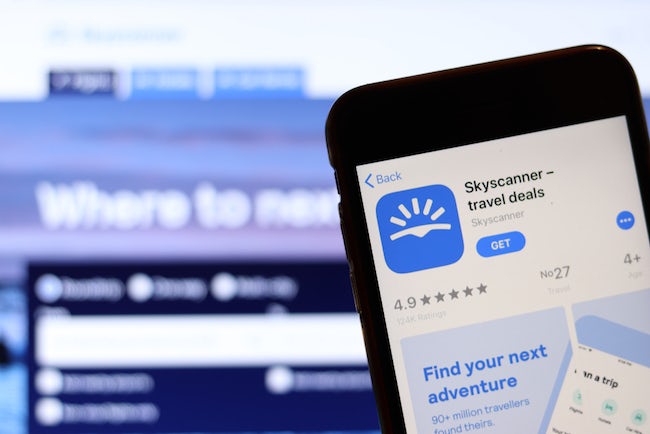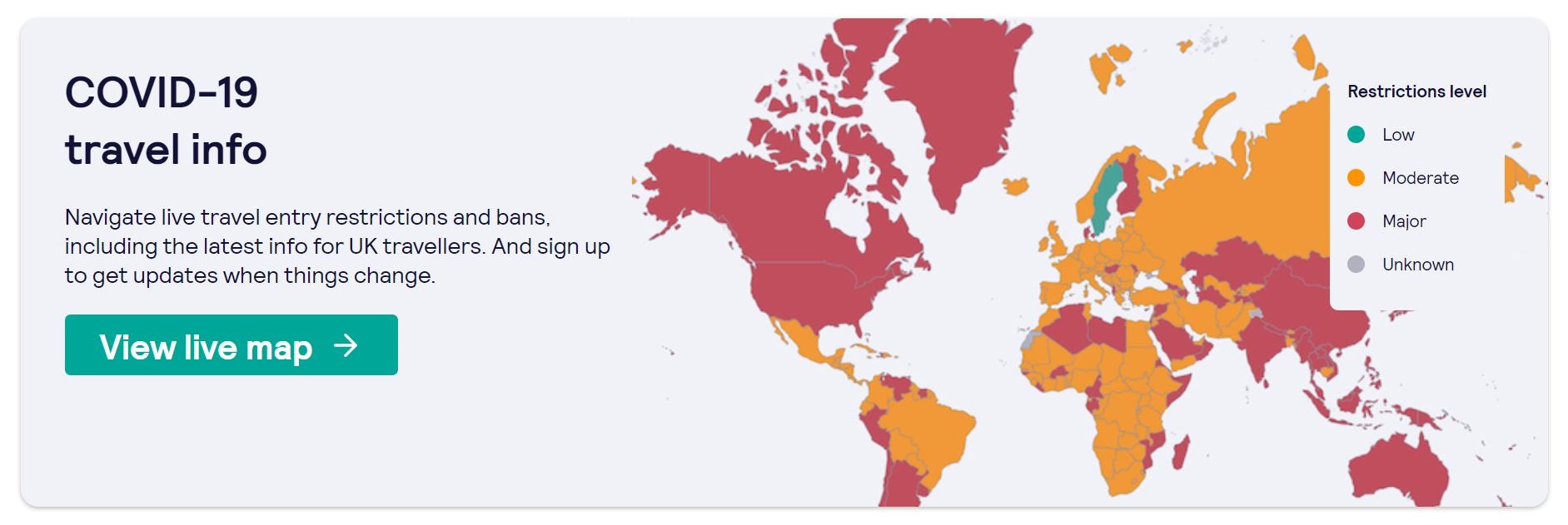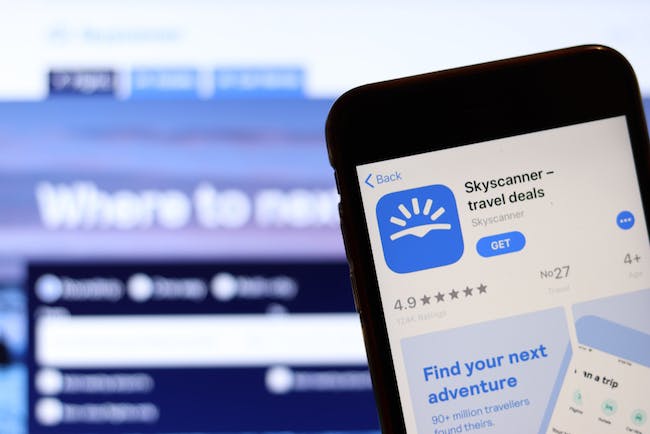Oli Mival, Director of User Research at Skyscanner, explains how the brand used user insight and testing to stay ahead of quickly shifting trends in travel.

For travel companies and those in the hospitality industry, one of the biggest obstacles to navigating the coronavirus pandemic has been a lack of certainty.
With travel restrictions constantly shifting and changing, consumers – even those who want to travel – have been wary of committing to booking a trip, unsure about how to navigate the hurdles posed by quarantine and testing requirements, or unwilling to take the risk of venturing onto a plane or into a hotel. Meanwhile, businesses have found the uncertainty challenging to prepare for – and have difficulties reassuring consumers when they themselves have no idea what’s ahead.
Travel comparison website and agency Skyscanner has found a way to combat this. For the past three or four years, the company has conducted frequent customer research and user testing in order to get a sense of what its customers are feeling, and how they are using its products. During the Covid-19 pandemic, this point of contact with the public has become invaluable, and has enabled Skyscanner to stay abreast of an evolving situation globally while taking steps to reassure consumers about the safety of travel.
I spoke to Oli Mival, Director of User Research at Skyscanner, about what kinds of insights Skyscanner has gleaned from its customer base, how it has evolved its product to help consumers navigate travel during the pandemic, and why “understanding people first” is invaluable for Skyscanner.
Understanding and tracking the consumer mindset
“When it comes to user research, I always take as my starting point that quote from Charles Kettering, who was the Head of Research for General Motors back in the 1920s,” says Mival. “He had this idea that, ‘A problem well-stated is a problem half-solved.’”
When it came to solving the ‘problem’ of the coronavirus pandemic, Skyscanner’s partnership with user insight and UX testing platform UserTesting, which had begun three or four years prior, suddenly came into its own, “because obviously our capacity to talk to people face to face was severely limited.”
Back in March, as the pandemic was beginning to escalate, Skyscanner formulated five core questions that would help them understand travel sentiment, needs and attitudes, and inform the work of their product, branding and marketing teams as well as their commercial operation as the company sought to return to growth.
“During the first wave of the pandemic in March and April, we wanted to find out: who are the people currently booking travel? What are their motivations? Who are the people considering booking travel, and what are their motivations and also their reservations? And who are the people who are not willing to even consider booking, and why is that?” says Mival.
“We also wanted to know what made the number of people in these groups decrease, or fluctuate, and how that changed by market – because we saw the impact first off in APAC, and then it came across to Europe before heading into the US and the Americas.
“It was really about understanding what was going on in people’s minds, and how that was starting to change,” Mival concludes. Assessing all of this required the user research team to work closely with their colleagues in data science, and to go out and conduct qualitative traveller interviews – both within their user base and outside of it.
“From the middle of March, we began speaking to 20 travellers from across the world every other week. We did this through the UserTesting platform – that was our core way of being able to understand, ‘What are people in South Korea thinking? What are people in Brazil thinking? What are people thinking in China or India or Germany? It was really important to us that we had that global perspective, so that we weren’t being too UK-centric. Without UserTesting, that would have been impossible.”
Having this regular touchpoint with customers enabled Skyscanner to understand consumers’ concerns and mindset not just in an isolated moment, but as they evolved over time. “We could see what people were thinking at that point, what they were expecting to see in the future, and then [later on] seeing whether that was what they felt,” says Mival. “That’s also one of the important things, because what people say and what they do are often quite different.”
User testing – an introduction for marketers
To travel or not to travel?
By checking in with and talking to travellers at regular intervals, Skyscanner gleaned some worthwhile insights about people’s motivations for travelling at different stages of the pandemic. “People who were willing to travel very clearly had a difference in attitude to risk,” he explains. “Attitude to risk is an interesting thing – it’s an underlying psychological property. We have a core aversion to risk, but the threshold of that risk can be reframed based on context.
“What I mean by that is that what we saw during the initial spike in March and early April was a lot of people repatriating – people going home, people going, ‘I’m not going to be able to travel past a certain date, so I need to get back’ – so there was a lot of one-way travel. You might get someone who has a high health concern, but that’s trumped by the emotional need to get somewhere.
“So, that idea of meeting that threshold of comfort led to a very clear difference in rationale as to why people were travelling. A leisure trip or a holiday would be very different from a very emotionally-driven need like getting back to see family or friends.”
Mival notes that this attitude didn’t vary hugely between demographics from different parts of the world; although there were differences in travel restrictions from region to region and different attitudes to border control or quarantine, the “underlying rationale” for travel was largely the same. “Humans are more similar than they are dissimilar,” he says.
Overwhelmingly, the two major fears that dissuaded people from booking travel were the fear of financial risk – the inability to change their bookings or claim a refund if the situation changed – and fear of health risk. Social pressure – the fear of being perceived to do something wrong – was another key factor, and Mival noted that social pressure had a slightly bigger impact on Asian consumers’ (lack of) desire to travel than it did on consumers in Europe or the United States.
The user research team used something called the Tolerance of Ambiguity Framework, developed by psychologist Stanley Budner in 1962, to quantify the attitudes that they were seeing from consumers in their interviews. “Travel had become a highly ambiguous experience, and there was a high number of factors contributing to that,” says Mival. “We learned very early on from the interviews that the key thing blocking people from booking travel was simply uncertainty. Uncertainty as to when restrictions would lift; when the government would clear travel as being safe; when flights were going to run, or be cancelled; there was a long old list.
“As restrictions began to ease, we saw that those with a high tolerance for ambiguity reached that comfort threshold I mentioned and began to book travel again. The Tolerance of Ambiguity measure allows us to see the relationship directly between people’s tolerance to ambiguity and the likelihood to book travel at scale. This was pretty robust across markets – there was no difference between the US, the UK, Japan, Australia, South Korea.”
Surfacing the information that travellers need to make decisions
Structurally speaking, the user research team at Skyscanner sits within design and product, which aids the process of translating insights from Skyscanner’s research and testing into product improvements and developments. But the work of the user research team informs all parts of the business.
“I’m really lucky – I actually get to work across pretty much every discipline,” says Mival. “I think the only one I probably don’t deal with day-to-day is Legal.” Insights from user research inform everything from tone of voice in marketing campaigns to social strategy and PR, product direction and the development roadmap.
“What’s great is that the visibility of our activities over the last nine months means that the org is really dialled into what we’re selling at the moment,” says Mival. “It doesn’t just help Skyscanner – what we’re doing is really helping our partners, giving them advice on how best to recover. We have an internal mantra of ‘traveller first, partner second, Skyscanner third’.”
On top of providing its partners with information like passenger volumes and search data, Skyscanner has incorporated sentiment tracking capability into Travel Insight Vision, a product that is used by many of its partners. “We’ve been running a survey in the last nine months in 19 markets that has had over 265,000 participants so far. What we do is track sentiment around travel and Covid, across those 19 markets across those nine months. And that’s available to any party that is interested in travel attitudes as part of our Travel Insight Vision product.”
What adaptations has Skyscanner been making to its consumer-facing business and products to help customers feel confident enough to travel? “Everyone wants to travel – the desire is really pent-up; but there’s so much uncertainty right now. The company focus has been really strong on reducing those anxieties,” says Mival.
“We have to do that by providing the right information in an unambiguous a manner and in as helpful as manner as possible. That’s core to the decisions that we’ve made at a really strategic level.”
For example, one of the main product changes that Skyscanner has implemented has been the creation of a Covid restrictions map that provides a live overview of different travel restrictions across the world and allows users to sign up for alerts on when restrictions change. “People haven’t known where or how or when they could travel, and that’s probably been the core product we’ve launched as part of the Covid response,” says Mival.

A live map of changing travel restrictions helps consumers to feel informed about where they can travel, while also providing additional information on Covid-19 case numbers and quarantine requirements in the destination region. (Image: Skyscanner)
Skyscanner has also begun surfacing information like flight cancellation policies within search results, and providing information like hygiene ratings for accommodation and airlines – all things that will help travellers to make an informed decision about how to go abroad and give them more confidence about booking a trip. “We’re giving people the information that we know they need to be able to make a decision comfortably and confidently,” says Mival. “I think as the vaccines roll out, that’s going to be another part of it.
“It’s always about understanding what the information is that people need and want, and then how can you surface it to them in a way that’s helpful and keeps them as informed as possible.” This is where the user testing part of Skyscanner’s partnership with UserTesting comes in: ensuring that their product is meeting the needs that the team has identified.
“A very big part of what we do, especially within the product design and product management teams, is that core of usability testing and value proposition testing,” Mival says. “We learn something, we build something, and then we see whether we’ve built it well.”

Skyscanner’s flight search engine surfaces additional details about airline flexibility and cancellation policies, where applicable, and also provides would-be travellers with information about hygiene measures being taken by airlines and hotels. (Image: Skyscanner)
Using evidence-based insight to inform decision-making
Mival is heartened by the way that the entire company has integrated the insights from user testing and customer insight across all levels of the business. “It’s been really exciting to see the company using insight to inform and drive decisions – both strategic and tactical,” he says. “It’s really become the norm – it used to be a bit of North Star objective, something that I was trying to push for as the way that we operated. There’s nothing quite like a pandemic to make people realise, ‘We need to be driving this based on evidence, and what people really feel and think.’
“It’s been a rollercoaster ride for us, but it’s been amazing to see how the company has doubled down on our team – and not just our team, but insights in general,” Mival goes on. “It always comes down to people – they’re the single most important thing, and to really understand what’s going on in people’s heads, you need to talk to them. It’s really powerful when you can put that qualitative data alongside the quantitative data to get a true picture of what’s going on.”
Looking into the future, Mival believes that the company will continue to take this insight-driven approach to strategy and decision-making even when the pandemic begins to subside. “The thing that we’ve really learned is that you have to drive decision-making based on evidence and foundational insight,” he says.
“The process that we’ve had to implement in wartime, in a sense, really has shown us the right way to do things, and the impact of doing things from that insight-driven perspective. This has given us the capability to make decisions that we otherwise couldn’t – that’s a learning that isn’t going to go away.
“The learnings and the insights that we’ve gained so far have a Covid lens, but in many ways, it just shows what we can do better – how we can provide peace of mind now. That isn’t going to go away any time particularly soon; the lag of this is probably going to be two or three years. And the learnings that we have about how to help people make the decisions that they need to make – that won’t necessarily change.
“There’ll be other lenses that are more applicable once Covid is a distant memory, but it won’t change the process of understanding people first, leading us to build the best products and communicate with people in a way that makes that sense.”
Customer experience trends in 2021: What do the experts predict?







